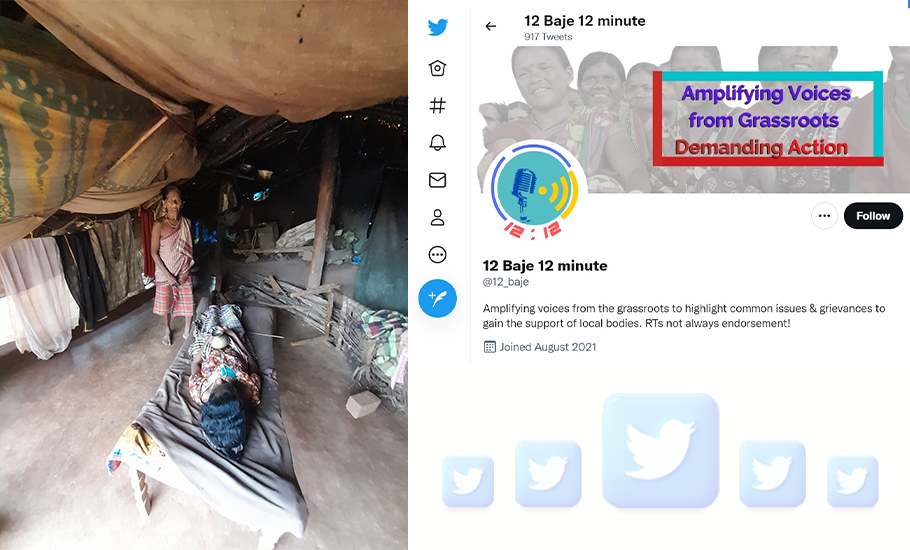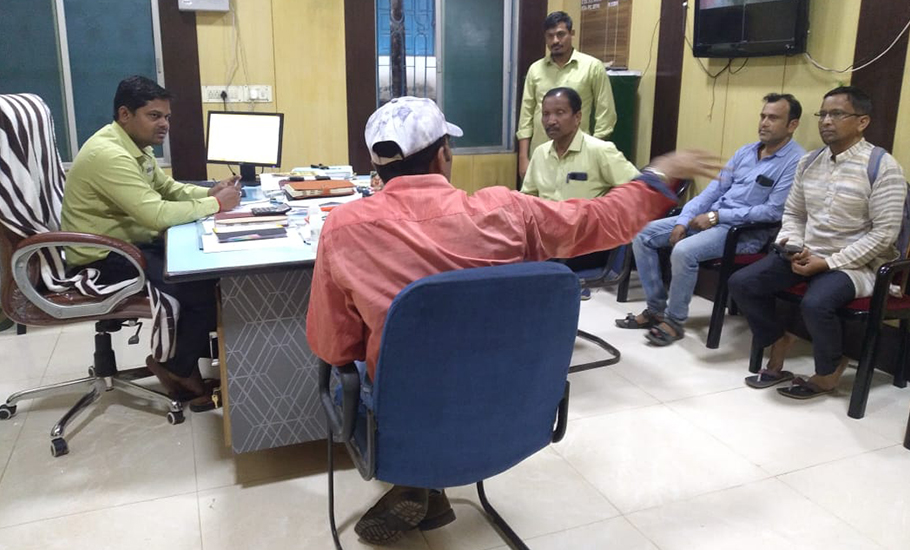
- Home
- News
- Analysis
- States
- Perspective
- Videos
- Education
- Entertainment
- Elections
- World Cup 2023
- Features
- Health
- Budget 2024-25
- Business
- Series
- NEET TANGLE
- Economy Series
- Earth Day
- Kashmir’s Frozen Turbulence
- India@75
- The legend of Ramjanmabhoomi
- Liberalisation@30
- How to tame a dragon
- Celebrating biodiversity
- Farm Matters
- 50 days of solitude
- Bringing Migrants Home
- Budget 2020
- Jharkhand Votes
- The Federal Investigates
- The Federal Impact
- Vanishing Sand
- Gandhi @ 150
- Andhra Today
- Field report
- Operation Gulmarg
- Pandemic @1 Mn in India
- The Federal Year-End
- The Zero Year
- Premium
- Science
- Brand studio
- Home
- NewsNews
- Analysis
- StatesStates
- PerspectivePerspective
- VideosVideos
- Entertainment
- ElectionsElections
- Sports
- Loading...
Sports - Features
- Budget 2024-25
- BusinessBusiness
- Premium
- Loading...
Premium

How social media became the last resort for Odisha villages to air grievances

On September 1 at 12.01 pm, a Twitter account ‘12 baje’ tweeted the plight of Budri Madhi, a resident of the tribal-dominated Malkangiri district in Odisha, who was being denied widow pension due to discrepancies in the documents. Though the amount was meagre, it meant the world to Budri Madhi as the pension is the only source of income she has after her husband died in 2020. Three months...
On September 1 at 12.01 pm, a Twitter account ‘12 baje’ tweeted the plight of Budri Madhi, a resident of the tribal-dominated Malkangiri district in Odisha, who was being denied widow pension due to discrepancies in the documents.
Though the amount was meagre, it meant the world to Budri Madhi as the pension is the only source of income she has after her husband died in 2020. Three months ago the government stopped paying the pension to the old widow. Upon enquiring she was told that her documents had some discrepancies.
Forty-nine-year-old Budri Madhi ran from pillar to post to get the authorities to release her pension but to no avail.
But in less than a week of the tweet put out this month, the collector’s office came out with an official report and directed the district social security officer and other administrative stakeholders involved to resolve the issue.
ନାମ ବୁଦ୍ରି ମାଢୀ ସ୍ଵାମୀ ଡମୁ ମାଢୀ ଗ୍ରାମ ଟେକ ଗୁଡା ଗ୍ରାମ ପଞ୍ଚାୟତ ପରକନମାଲା ବିଧବା ବତ୍ତା ରୁ ବଞ୍ଚିତ ଅଛନ୍ତି ।ବ୍ଲକ ଖଇରପୁଟ Please make necessary arrangements @CMO_Odisha @dm_malkangiri @SSEPD2 @MoSarkar5T #12baje12minute #GrassrootsNarratives pic.twitter.com/PhZf7PED3Q
— 12 Baje 12 minute (@12_baje) September 1, 2022
On September 19, the same handle tweeted the plight of 52-year-old Rasai Khilla, a resident of Poda Colony in Malkangiri, who had not received her social security pension for the last three months. On September 26, the district collector’s handle tweeted a report signed by the Block Development Office (BDO), saying that Rs 2,000 had been transferred (Rs 500 per month from June onwards) to Rasai Khilla’s account.
Dear Sir,
Thank you so much for your quick response.@CMO_Odisha @dm_malkangiri pic.twitter.com/ZTLrEghUxq— 12 Baje 12 minute (@12_baje) September 27, 2022
Lakhs of cases like that of Budri Majhi and Rasai Khilla have been pending in Odisha for years both due to apathy on part of government officials and a dearth of efficient grievance redressal mechanisms.
With the digital footprint yet to reach the remote corners, grievance redressal system through social media is still a luxury for many residing in the villages. According to the National Family Health Survey-5 data (from 2019-2021), while 72.5 per cent of the urban males and 51.8 per cent of the urban females have ever used the internet, only 48.7 per cent of rural males and 24.6 per cent of the rural females have even used internet.
To tide over the challenge, a group of social activists in Odisha have turned themselves into the bridge between the villagers and the public administration.
The digital movement of sorts began during the pandemic, when the activists working with the grassroots realised the power of social media.
The pandemic-induced lockdown had restricted the movement of the villagers, who would usually visit the local BDO, or the office of the collector, to raise various kinds of grievances where they would be made to wait for hours and being turned away or being asked to visit another day. Since the lockdown had restricted everyone’s movement, even the social activists couldn’t extend help.
Normally, they would accompany the unlettered or semi-literate villagers and help them complete the necessary formalities such as filling up forms or write applications. They would also help the villagers understand processes.
When lockdown restricted movement and people were desperately looking for ways to find solutions, the activists took the problems being faced by villagers to social media.
At that time a common problem the people were facing was the non-availability of ration cards. When they highlighted cases where people were unable to receive subsidised foodgrain, the then food supplies minister Ranendra Swain reached out with help asking the activists to collate a list and send it to his office so that ration cards could be issued at the earliest.
“We had a couple of instances of flagging people’s problems on social media. But during the pandemic we made a concerted effort. We were more careful in using the right hashtags and tagging the right people. Fortunately, our posts were noticed by top authorities and even got the responses, which made us realise the potential of 280 characters on the internet,” says Nityananda, a social activist working in the state.
Initially, the social workers would tweet from their individual handles or use their organisations’ official handle and amplify it by sharing with other activists. But Nityananda decided to take a more organised approach and created an account ‘12 baje 12 minute’ on Twitter with its handle named @12_baje in August 2021. As the account’s name suggests, the messages are tweeted at noon and then amplified over the next 12 minutes to gain maximum attention. Nityananda efforts have found support from other like-minded people.
“A dedicated handle gave some sort of authenticity to the cause. Of course, we still post on our own social media handles too, but through @12_baje, we select and highlight the issues or grievances that require urgent attention,” Nityananda tells The Federal.
As people’s grievances began to find quick solutions, the exercise inspired faith among villagers, who despite not knowing the technicalities and the functioning of social media, are reaching out for help through social workers.
“Our village was facing water issues for almost three decades. We would rely on the river flowing near our village for most of our needs. But some people who were working in the village took our details and posted on @12_baje and within one month, we got tap water connection,” says Samant, chief of a village in Malkangiri under Khairput panchayat.
Members of the group say they do not have the manpower or logistical support to maintain a record of how many people received help through @12_baje, they say that the response has been encouraging.
“In a closed office space, you can easily turn down the request of an eligible beneficiary or intentionally delay the work. But on social media, where the world is watching, the officials wouldn’t want any controversies. They want to portray a good image and give out a sense that things are working well and fast. So, the grievance redressal system becomes quick and effective. In most cases, we have seen the collector respond and sometimes even ministers have intervened,” says Laxmidhar Singh, another activist associated with the cause.

Those working on connecting villagers with their administration through social media follow a strict process to decide what is posted from their handle. To avoid propagating false cases, a video documentation is done along with proofs of relevant papers.
One handle is surely not enough to make a difference. The social activists involved in the exercise also believe that the ultimate aim of the exercise should be to empower the villagers. So, they are working on training the educated youth in Odisha’s villages to create their own social media handles and post their grievances themselves by tagging the right people. Several Twitter accounts such as MJSM & JSM Kandhamal, SJS & MSJS, Malkangiri, JJM, MAYURBHANJ have sprung up in the recent past with the sole objective of finding help for the poor people living in Odisha’s villages.
“It is a way to empower them. We select four to five youngsters in a village and train them on what to tweet and how to tweet it, tagging the right officials. Then, we help them create a Twitter account in the name of their villages and start posting accordingly. It is done after taking permission from the villagers. The work is still in its nascent stage,” says Santanu, who works with an NGO in Kandhamal district of Odisha.
Being a collaborative effort, the outreach is encouraging as different organisations have lent their resources to the effort. So far, the work has spread to 17 of the 30 districts in the state.
“There is a sense of work satisfaction. Earlier, we would run from pillar to post to get the attention of the authorities over a matter. Now, the work can be done with a few words and just a few clicks,” says Jitendra Khilli, who coordinates the work in Malkangiri district.
While the efforts have so far helped the villagers, there are pitfalls too.
“Not every issue or grievance requires the attention of the top authorities. Some of the work can be done at the local level itself. But since most of the local authorities are not on social media, we are forced to tag the top officials, who then ask their juniors to take up the case. This doesn’t always go down well with the immediate authorities who take the whole thing as a personal offence. They turn cold to the villagers,” says Laxmidhar.
On the record, however, officers are supportive of the move.
“At times, certain issues do skip the attention of the administration. So, highlighting it helps us address it faster. Most of our senior officials are active on social media and immediately alert us if some issue comes to their notice. At our own level, we have also formed an unofficial WhatsApp group of sorts connecting villagers and activists with immediate officials,” says a panchayat-level official based in Khairput of Malkangiri district.

